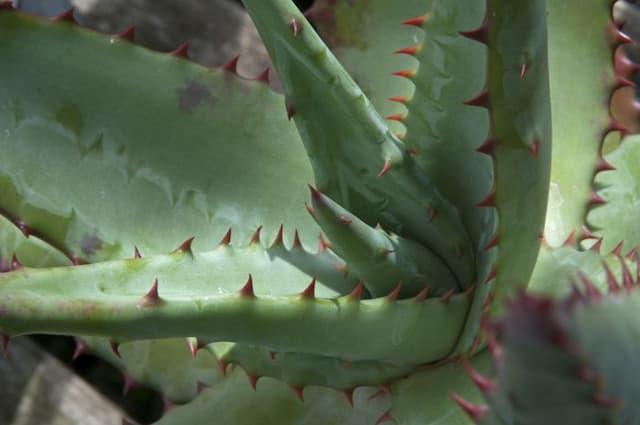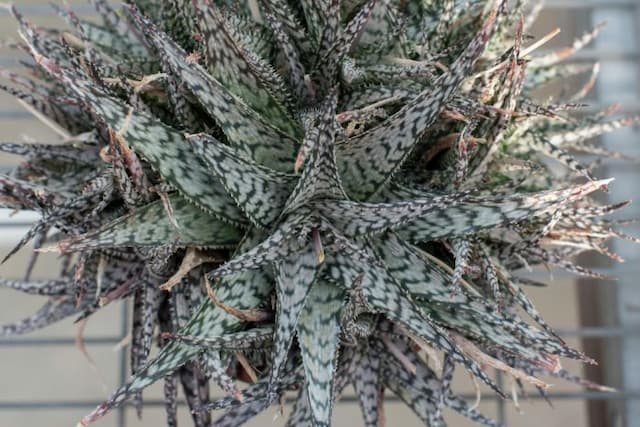Red Hot Poker Kniphofia 'Ice Queen'

ABOUT
The Ice Queen is a striking perennial plant known for its unique flower spikes. It has long, slender, grass-like leaves that grow in a clumping, arching fashion, creating a tufted base from which the flower stems arise. These leaves are deep green in color, giving the plant a lush, vibrant appearance. The most remarkable feature of the Ice Queen is its tall spikes of tubular flowers that are arranged densely around each stem. These flowers start off with a light greenish tint at the base and gradually transition to a creamy white as they move towards the tips. The flower spikes resemble a flamboyant, torch-like display, giving the Ice Queen an exotic and fiery appearance, in contrast to its cooler color palette. As the plant blooms, these spikes of flowers create a highly textural and visual impact in the garden. The color of the flowers is quite striking, with the creamy white blossoms standing out against the dark green foliage. These flowers typically bloom in succession from the bottom up, providing a prolonged display of color. Overall, the Ice Queen presents a blend of elegance and dramatic flair with its slender foliage and striking, towering flower spikes, making it a captivating addition to any garden space designed for visual interest.
About this plant
 Names
NamesFamily
Asphodelaceae.
Synonyms
Torch Lily, Red Hot Poker, Poker Plant.
Common names
Kniphofia 'Ice Queen'
 Toxicity
ToxicityTo humans
Red hot poker plants, including the variety Kniphofia 'Ice Queen', are not commonly known to be toxic to humans. There are no well-documented cases of poisoning from ingesting parts of this particular plant, and it is generally considered non-toxic. However, it’s always prudent to be cautious with plants, as individual reactions can vary and some parts of plants could cause irritation or an allergic reaction if ingested.
To pets
Red hot poker plants, such as Kniphofia 'Ice Queen', are typically not listed as toxic to pets. While they are not considered highly poisonous to cats and dogs, ingestion of plant material can sometimes lead to gastrointestinal upset in pets, such as vomiting or diarrhea, due to the irritation of the stomach or intestines. If your pet has eaten a part of this plant and is showing symptoms of distress, it is best to consult with a veterinarian.
 Characteristics
CharacteristicsLife cycle
Perennials
Foliage type
Evergreen
Color of leaves
Green
Flower color
Creamy-white
Height
3-4 feet (0.9-1.2 m)
Spread
2-3 feet (0.6-0.9 m)
Plant type
Herbaceous
Hardiness zones
5-9
Native area
South Africa
Benefits
 General Benefits
General Benefits- Attracts pollinators: The vibrant flowers of the Ice Queen, commonly known as the Red Hot Poker, are adept at attracting bees, butterflies, and hummingbirds, which are vital for pollination.
- Drought tolerance: Once established, the Red Hot Poker is known for its ability to withstand periods of low water, making it suitable for xeriscaping or drought-prone gardens.
- Low maintenance: This plant is generally easy to care for, requiring minimal upkeep once it has settled into its growing environment.
- Long blooming season: The Red Hot Poker blooms for an extended period, usually from late spring through summer, providing long-lasting color in the garden.
- Architectural interest: With its tall flowering spikes and grass-like foliage, the Red Hot Poker adds structure and interest to garden beds and borders.
- Cold hardy: It is capable of withstanding cooler temperatures, making it suitable for a variety of climates and adding versatility to its planting options.
- Deer resistant: The Red Hot Poker is generally not favored by deer, making it an excellent choice for areas where deer browsing can be a problem for gardeners.
- Erosion control: The robust root system of the Red Hot Poker can help stabilize soil and prevent erosion on slopes and banks.
 Medical Properties
Medical PropertiesThis plant is not used for medical purposes.
 Air-purifying Qualities
Air-purifying QualitiesThis plant is not specifically known for air purifying qualities.
 Other Uses
Other Uses- As a natural dye: The flowers of the Red Hot Poker can be used in the production of a natural dye for fabrics, providing a range of warm, earthy tones depending on the mordant used.
- Included in cut flower arrangements: Due to their striking appearance and lengthy bloom time, Red Hot Poker flowers add a unique and long-lasting element to floral displays and bouquets.
- Garden architecture: Adding vertical interest and a spiky texture, they can be used in garden design to create focal points and contrast against more rounded plant forms.
- Moth attractant for night pollination: The bright flowers of the Red Hot Poker can attract moths during the evening, aiding in garden pollination.
- Erosion control: With their extensive root systems, they can be planted on slopes or areas susceptible to erosion to help stabilize the soil.
- Indicator of soil pH: Observing the vigor and bloom quality can give anecdotal evidence about the soil's alkalinity or acidity, thereby acting as a natural soil pH indicator.
- Creating garden habitats: Red Hot Poker's robust nature can provide shelter and food for small wildlife, contributing to the overall habitat diversity within a garden.
- Education: The distinctive flowering pattern and bird-attracting qualities make it useful for educational purposes in schools and botanical gardens to teach about plant-pollinator interactions.
- Natural fencing: When planted in a row or a cluster, their height and volume can function as a living fence or privacy screen in the garden.
- Photography: With their eye-catching blooms, Red Hot Pokers are often subjects for photographers who wish to explore shapes and colors in nature photography.
Interesting Facts
 Feng Shui
Feng ShuiThe Red Hot Poker is not used in Feng Shui practice.
 Zodiac Sign Compitability
Zodiac Sign CompitabilityThe Red Hot Poker is not used in astrology practice.
 Plant Symbolism
Plant Symbolism- Vibrancy: The striking appearance of the Kniphofia 'Ice Queen', also known as Red Hot Poker, symbolizes vibrancy and the ability to stand out in a crowd due to its bold and vivid flower spikes.
- Attraction: Its bright flowers tend to attract hummingbirds and butterflies, representing the power of attraction and the importance of being a beacon for others.
- Strength: The Red Hot Poker is a hardy plant that can thrive in tough conditions, symbolizing strength and resiliency in the face of adversity.
- Passion: Its fiery colors are often associated with passion and high energy, making it a symbol for living life with intensity and fervor.
- Transformation: As the plant progresses from bud to full bloom, it symbolizes transformation and the idea of blossoming into one's full potential.
 Water
WaterThe Red Hot Poker should be watered deeply about once a week. This is especially important during dry periods or when it is establishing roots. To hydrate the plant sufficiently, provide about 1 gallon of water, ensuring it reaches the deeper roots without causing waterlogging. During hotter months, increase the frequency, but allow the soil to dry out between waterings. As the plant is drought-tolerant, overwatering can be more detrimental than under-watering.
 Light
LightRed Hot Poker plants thrive in full sun conditions, requiring at least 6 hours of direct sunlight daily. Plant it in a location where it can receive unfiltered sunlight throughout the day, which is vital for bloom development. Avoid shaded areas as insufficient light can reduce flowering and weaken the plant.
 Temperature
TemperatureRed Hot Poker plants are suited to a wide range of temperatures and are hardy in USDA zones 5 through 9. They can survive minimum temperatures down to 10 degrees Fahrenheit, but ideally, they prefer temperatures between 50 to 75 degrees Fahrenheit. They are not suited for extremely cold conditions and prolonged exposure to temperatures below 10 degrees Fahrenheit can be harmful.
 Pruning
PruningPruning the Red Hot Poker should be done to remove spent flower spikes and encourage further blooming. Deadheading can be performed throughout the flowering season as individual blooms fade. In late fall or early spring, cut back any dead or damaged foliage, which helps to maintain plant health and appearance. Pruning should be done with clean, sharp tools to prevent damage to the plant.
 Cleaning
CleaningAs needed
 Soil
SoilThe Red Hot Poker 'Ice Queen' thrives best in well-draining soil that is rich in organic matter. A soil mix that consists of loam, compost, and sharp sand or perlite in equal parts will promote healthy growth. The ideal pH for this plant is slightly acidic to neutral, ranging from 6.0 to 7.0.
 Repotting
RepottingRed Hot Poker 'Ice Queen' generally does not require frequent repotting and can be repotted every 2 to 3 years. It's best to repot when the plant has outgrown its current container or when soil conditions begin to deteriorate.
 Humidity & Misting
Humidity & MistingRed Hot Poker 'Ice Queen' is tolerant of a range of humidity conditions and does not require high humidity to thrive. Average room humidity or outdoor ambient humidity is generally adequate for this resilient plant.
 Suitable locations
Suitable locationsIndoor
Provide full sun, well-drained soil, and avoid overcrowding.
Outdoor
Plant in full sun, enrich soil with compost, ensure good drainage.
Hardiness zone
5-9 USDA
 Life cycle
Life cycleKniphofia 'Ice Queen', commonly known as Red Hot Poker or Torch Lily, begins its life cycle when the seeds are sown in early spring or by division of mature plants. The seeds germinate in warm, well-drained soil, and seedlings eventually develop into a rosette of narrow, arching leaves. As the plant matures, a sturdy, upright flower stalk emerges from the center of the rosette in late spring to summer, bearing a spike of tubular, pale green to white flowers that attract hummingbirds and bees. After flowering, the plant sets seed, which can be collected for propagation or left to self-sow in favorable conditions. Throughout the growing season, Kniphofia 'Ice Queen' requires regular watering and full sun exposure to thrive. In winter, the plant becomes dormant, with the foliage dying back in colder climates, requiring mulching for protection, and regrows from its perennial rhizome as temperatures rise in spring.
 Propogation
PropogationPropogation time
Spring to summer
The Kniphofia 'Ice Queen', commonly known as the Red Hot Poker, is commonly propagated by division, which is best done in the spring. To propagate by division, carefully dig up an established clump of Red Hot Poker and gently separate it into smaller sections, ensuring that each section has a portion of the root system and several shoots. These divisions can then be immediately replanted in well-draining soil, spaced about 18 inches (approximately 45 centimeters) apart to allow for growth. Water the new divisions thoroughly after planting to help establish them. Dividing the plant not only propagates new ones but also rejuvenates the parent plant, encouraging more vigorous growth and flowering.









